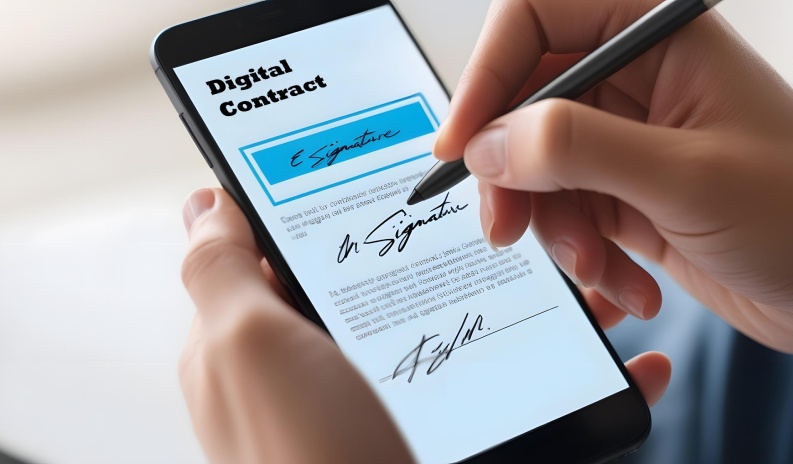How E-Signatures Simplify Legal Document Workflow?
by Mashum Mollah Technology Published on: 05 September 2024 Last Updated on: 14 May 2025

The legal sector, just like others, is aiming to get the benefits of scaling digitization. They are trying their level best to embrace new technology to make their complex work seamless.
However, the rapid use of electronic signatures or e-signatures bears testimony to the earnest efforts of the legal world to better serve the needs of people.
But what are e-signatures, and how do they simplify the workflow processes for legal documents? Yes, we are discussing it all here to make the topic easy for you to understand in the simplest of expressions.
What Are E-Signatures?

E-signatures are handwritten signatures but in digital format. The benefit of it is that you can sign the electronic document with no fear of forging.
Just as the signs are done in hardcopies, these signatures bear the same value, thanks to laws and regulations in many countries that recognize their validity.
Benefits Of Electronic Signature For Legal Documents

In this section, we try to understand some of the benefits of the electronic signature for legal documents.
Optimizing Workflow
Before, you had to print the documents and get them signed by the respective people. Then, the papers were scanned before being sent to multiple parties via email.
This was the traditional work process that existed for quite some time.
However, the E-signatures have simplified things by allowing you to sign documents electronically. Now, there is no need to print, scan, and then send the respective copies.
This saves an enormous amount of time and resources.
Additionally, signing and notarizing documents at any time and place has become convenient due to the availability of notary online services. Moreover, it has brought added flexibility because the concern of the signer’s location is no longer an obstacle for notarizations.
Cost-Effective
Another significant advantage of using e-signatures is the cost savings. Think of all the money spent on paper, ink, and postage.
By going digital, you not only save these costs but also reduce the physical storage space required for paper documents. This makes e-signatures an economical choice for law firms and legal departments.
Legal Validity
One of the primary concerns when it comes to electronic signatures is their legality. Fortunately, laws like the ESIGN Act in the United States and the eIDAS regulations in the European Union have established a legal framework that recognizes e-signatures as legally binding.
This makes it easier for legal professionals to adopt this technology without worrying about its validity in court. Yes, it is one of the benefits of using electronic signatures for legal documents.
Improved Client Experience
Clients today expect quick and convenient services. When you incorporate e-signatures into your legal workflow, you offer your clients the ability to sign documents from anywhere in the world, as long as they have an internet connection. This convenience can lead to higher client satisfaction and can even differentiate your services in a competitive market.
Enhanced Security
While traditional signatures can be forged, e-signatures offer a higher level of security. Advanced encryption and authentication methods ensure that the signer is who they claim to be. Some e-signature solutions also include a time-stamping feature that logs when and where the document was signed, adding another layer of security.
Environmental Benefits
In an age where businesses are increasingly conscious of their environmental impact, e-signatures offer a greener alternative. By reducing the need for paper and mail, you contribute to a significant reduction in your carbon footprint.
Remote Work Compatibility
The recent change towards remote work has highlighted the need for digital solutions in various sectors, including legal services.
E-signatures facilitate seamless transactions and document management in a remote work setting, making it easier for legal teams to collaborate without the need for physical presence.
This not only supports greater flexibility and effectiveness but also ensures that the transition to remote work does not disrupt legal operations.
Scalability
As law firms and legal departments grow, the volume of documents they handle increases exponentially.
E-signatures offer a scalable solution that can manage this growing demand without a corresponding increase in administrative workload.
This scalability is particularly beneficial for larger firms that deal with high volumes of documentation, enabling them to maintain efficiency and productivity as they expand.
Regulatory Compliance
Adhering to regulatory compliance is imperative in the legal sector, and e-signatures can help in this area as well. Many e-signature platforms are designed to comply with various regulatory standards, providing additional features like audit trails, secure storage, and user authentication.
These capabilities ensure that legal documents signed electronically meet stringent compliance requirements, thereby reducing the risk of legal challenges or penalties.
How To Use Electronic Signature For Signing A Document
There is a procedure for using the electronic signature for legal documents and other documents. After you receive the email from the sender with a request for signing, you click the link labeled, “Click here to review and sign.”
Then, you have to click on the “click here to sign” field to sign the document. Thereafter a pop up window will open. It will let you create your electronic signature in the document’s respective place.
Then, you will observe four options opening to you. However, the first is to type your name. The other is drawing with a mouse, uploading an image of your signature, and finally, signing with your finger on the screen.
After you select one from the above, you have to select “Apply to add your signature.” After you sign the document, you can get a preview of the signed document before approval.
Finally, select “Click to Sign.” It will finalize your electronic signature. Your signature will automatically be sent to the sender of the final signed document. This is the procedure that you usually follow with Adobe.
Electronic Signatures for legal documents have made Legal Workings Easy
E-signatures are more than just a contemporary convenience; they are a powerful tool that simplifies the legal document workflow. From saving time and money to enhancing security and improving client experience, the benefits are manifold. With the legal backing they have gained, there’s never been a better time to make the switch.
Additional Reading:



































































































